1 Prehistory
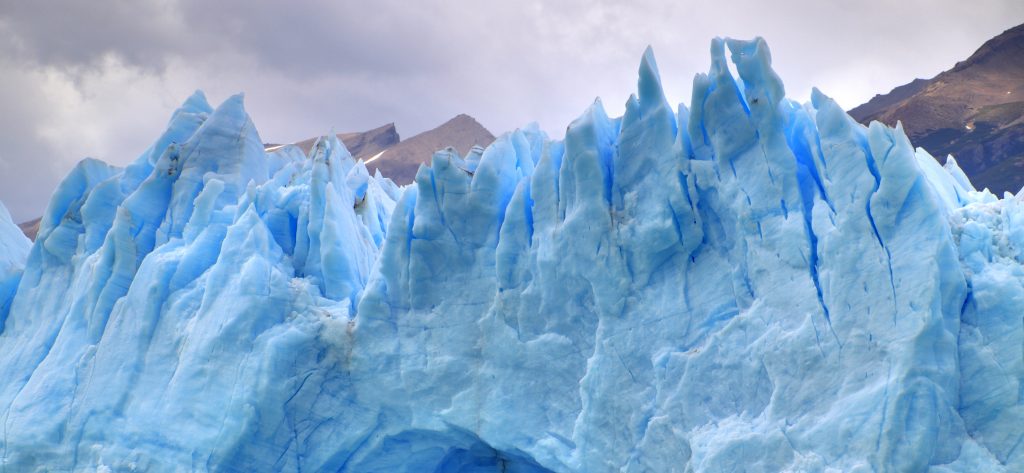
History is about understanding the past using the best resources available, and as new tools and information about the past become available, history changes. In recent decades, scientific breakthroughs have made it easier to understand the long centuries before people started leaving written records. This new information allows us to look farther back, and we’ve discovered that what happened long before the beginning of recorded history had a huge influence on our lives today.
A big part of this change in understanding the past, for Americans, is recognizing that our continent’s history does not begin with Columbus or even with the Vikings, but with the stories of people who arrived in the Americas ten thousand years before the first Europeans. America’s deep past was once thought of as just a prehistory that had no bearing on later events or on the present. As we’ll see, that view was mistaken.
Humanity evolved in Africa over a period of about a million years. When they left their original homelands, early humans first spread over the adjacent continents they could get to on foot, as you’d expect. Over thousands of years, these humans settled nearly all of Europe and Asia. But they didn’t reach the Americas, because during those early periods of expansion the Americas were separated by wide, un-crossable oceans. You may be aware that a long time ago the continents were all joined together in a landmass known as Pangaea. This is true, but that ended millions of years before the first humans evolved. By the time people came along, the continents and oceans were pretty much where they are today. The isolation of the American continents and the changes that occurred on them when global climate change allowed humans to finally reach them had a major influence on the beginning of our story.

People Like Us
Human expansion across the continents of Earth must have been an epic story of courage and tenacity. It’s too bad it all happened long before the invention of writing, which was only about five thousand years ago, so we can only speculate about what these people felt and thought about their adventures. Luckily, scientists have recently been able to tell us more about the environments these humans faced, and even about the people themselves. So we can now see at least an outline of this prehistoric epic.
The modern humans scientists call Homo sapiens have been around for close to two hundred thousand years, and for all that time they have been more or less physically and mentally the same as us. That’s an important point to remember. Ancient people lacked writing and other technology we enjoy today, but they had comparable physical and mental abilities. They looked like us and to a great extent they thought like us. A few scientists have even suggested that some prehistoric individuals may have had more highly developed physical and mental abilities than we do. After all, they had to survive by their strength and their wits to a much greater degree than many of us living in luxury today. Prehistoric hunter-gatherers who we once pictured as little more than ignorant cavemen adapted and thrived in conditions we’d have trouble facing even with our technology. A cavewoman might actually have an easier time getting along in our world of WIFI and supermarkets than we would have surviving in her world without all the modern conveniences we depend on every day.
The people I’m calling humans in this chapter include a wider variety of folk than you might expect. Until recently, it’s been common to reserve the term “human” for only the most recent branch of the evolutionary tree, Homo sapiens. It was thought there were extreme and obvious differences between us and our ancestors—that we were in fact different species. But as we learn more about our earlier ancestors, we’re discovering they are more like us than we had imagined. Neanderthals, for example, had bigger brains than we do and made stone tools very similar to those made by neighboring Homo sapiens.
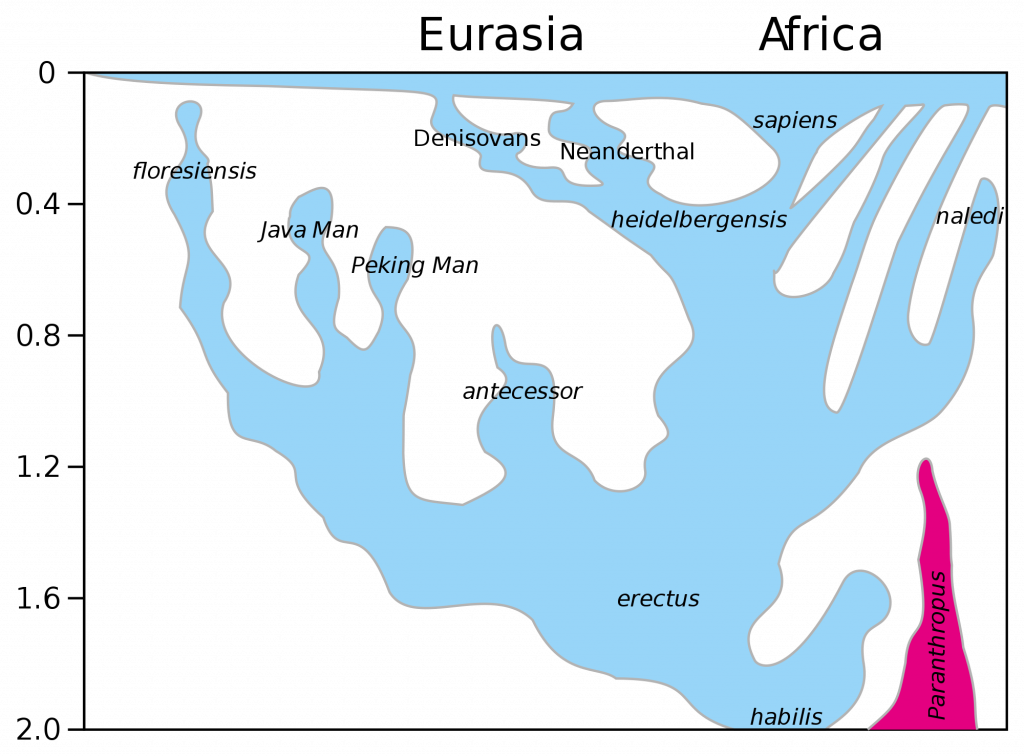
And these earlier people weren’t as isolated from their Homo sapiens neighbors as we had thought. One of the biggest discoveries geneticists have made in the past few years is that most modern humans carry genes from people like the Neanderthals and the Denisovans. Since the definition of a species includes being able to breed viable offspring, Neanderthals and early Homo sapiens who had children together were clearly much more closely related than we’d once believed them to be. So it makes sense to expand our understanding of humanity to include these people our ancestors mixed with. Maybe we can even learn something from them, as we discover more about their prehistoric lives.
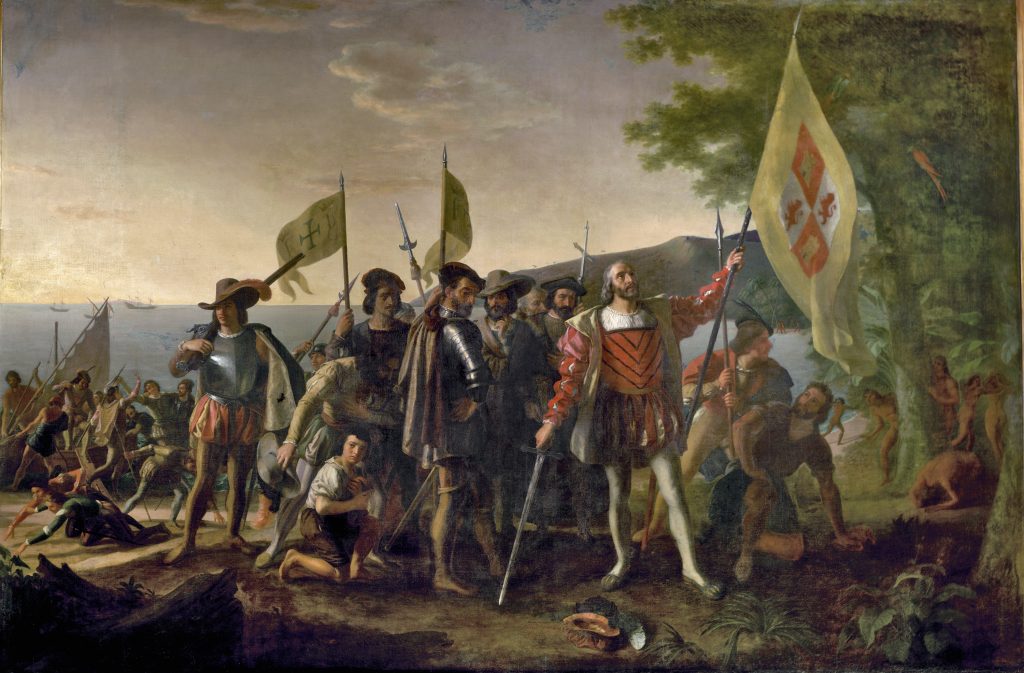
Before 1492
Now consider America. For most people—even for many historians—American history begins in 1492. Everything that happened before Europeans began exploring what we used to call the New World is still often considered to be prehistory. Remote, unknowable, and largely irrelevant. But is it really?
If you happen to be descended from the people who were here before Columbus, you would probably disagree with the idea that American History began in 1492. And actually, outside the United States most of the people in North and South America are descended at least partly from people who were here before Columbus. But even if all your people came to America on the Mayflower or on a slave ship or passed through Ellis Island, there still are reasons why American prehistory is an important part of your story. We’ll explore them in the rest of the chapter, but here are a few highlights:
- The people who settled the Americas came from the same ancestors as the people who settled Europe. In other words, we’re all related.
- The people who settled the Americas made one of the epic migrations in the history of our species. So it’s a great human adventure.
- Early Americans developed three of the five most important foods eaten throughout the world today. So they had a lot to do with making the modern world we live in possible.
One reason historians often skip over this prehistory is that most of its data comes from other fields of study. It’s obviously much harder to know what happened a long time ago, when people didn’t leave written records or when those records have been lost. This is a problem not only in the Americas, but throughout the world. Historians have learned to rely on anthropologists, archaeologists, geographers, and linguists to fill in the gaps in their knowledge. And more recently on climatologists, geneticists, geophysicists, and even satellite remote-imaging systems to help piece together the stories of ancient peoples and how they lived. As these sciences develop and as new techniques and data become available, our understanding of the remote past can change radically—and sometimes very abruptly. For example, our understanding of human origins has changed quite a bit in the since archaeologists first began discovering the bones of our distant ancestors.
The most up-to-date data available as I write suggests several waves of human migration out of Africa. The most recent wave—the one that leads directly to us—began roughly 80,000 years ago. Before that, around 150,000 years ago, some type of disaster seems to have reduced the Homo sapiens population in Africa to a couple thousand or maybe even just a few hundred people. This time period corresponds with the glacial maximum (the peak of the ice age) before the most recent one, so it’s likely that changes in weather patterns altered global patterns of vegetation, reducing the foods available to our ancestors. Scientists aren’t sure of the exact cause of the population crisis. What they do know, based on genetic analysis, is we are all descended from those few hundred Africans. The human population recovered gradually and some of the survivors began moving northward from their original homes in Central Africa as climate continued to change, probably following the animals they hunted.
But our Homo sapiens ancestors were not the first humans to travel the world. Homo erectus left Africa 1.8 million years ago and their descendants were incredibly successful. Homo erectus actually survived in East Asia until about 40 thousand years ago, when they were displaced by migrating Homo sapiens. A recently-discovered group called the Denisovans left Africa about 1.2 million years ago. The Denisovans settled in central Asia and contributed a crucial gene to modern people living in Nepal and Tibet that allows their blood to absorb more oxygen in the high altitudes of the Himalayas. And the ancestors of the Neanderthals left Africa about 600,000 years ago. They thrived in what is now Europe for more than a half million years, and contributed to the genomes of all modern non-Africans. Neanderthals were unbelievably tough. They survived through several ice ages and only disappeared about 25 thousand years ago when they too were displaced by Homo sapiens.
By about 40,000 years ago, a population of Homo sapiens hunter-gatherers descended from the people that had survived the African population crisis were living on the Eurasian plains north of the Black Sea. These are your ancestors, if you are Asian, European, or Native American. They used spears, fire, and cooperation to defend themselves from predators, and were experts at hunting huge prey animals like the woolly rhinoceros and woolly mammoth. The Eurasians’ ability to adapt to life on the plains and tundra gave them an evolutionary advantage when a new cycle of global cooling once again changed weather, vegetation, and animal migration patterns. These changes extended the hunter-gatherers’ habitats across the whole Eurasian land mass from the Atlantic to the Pacific.
Ice Ages
Global climate has been very stable for extremely long stretches of Earth’s 4.5 billion-year history, such as during tens of millions of years when dinosaurs roamed the planet. But over the last million years there have been a series of cyclical climate changes. Over the last 500,000 years (a period we have better data for), global temperatures have varied by about ten degrees Celsius (about 18° F) in a regular cycle lasting around 100,000 years. The highest temperatures were about three or four degrees Celsius higher than now, and the lowest were about six or seven degrees cooler. These are global averages, not local. On a global basis a six-degree Celsius drop in average temperature is enough to bring on an ice age. That’s exactly what happened during the cold part of each cycle. Snow fell and didn’t melt. Ice accumulated into glaciers that spread northward from Antarctica into the southern oceans and southward from the Arctic Circle to cover most of what is now Europe, all of Canada, and quite a bit of the northern United States. The last time this happened, roughly 36,000 years ago, is when American History really began.
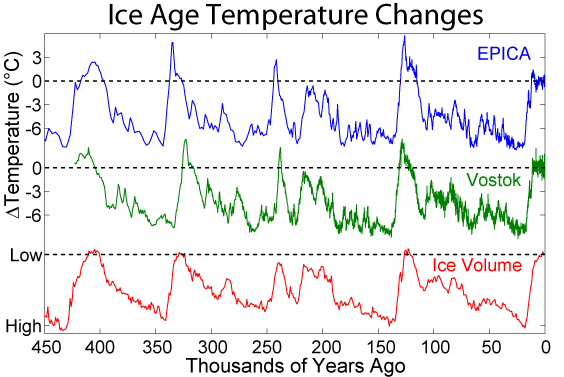
This chart shows the relationship between global temperatures and the Earth’s volume of ice. The ice volume line at the bottom is inverted so you can see how ice cover and temperature changes line up. When temperatures fell the ice-pack grew. Notice that about 150,000 years ago, Earth experienced the frigid temperatures of a glacial maximum. That’s the climate change that may have caused the population crisis in the African Homo sapiens mentioned earlier. As snow became trapped in glaciers, rainfall patterns changed in central Africa, killing plants that had evolved under different conditions. Lack of food reduced the numbers of grazing animals and the humans who hunted them. Later, when the climate warmed, Eurasian glaciers receded and opened new grasslands for the herds, forcing hunters to migrate along with their prey. After expanding across Europe and Asia during tens of thousands of years of mild weather, our ancestors once again faced centuries of cooling and finally another ice age beginning about 36,000 years ago. This climate change created new opportunities as well as challenges.
When global temperatures began to drop slowly at the beginning of the last ice age, the forests of central Europe and Asia died. Trees have a hard time adapting to big changes in climate, and slow-growing forests can’t relocate to places with better conditions as easily as other, shorter-lived plants. The Eurasian plains lost their trees and became grassy steppes and then frozen tundra. The onset of the ice age took centuries, and Eurasian hunter-gatherers gradually followed the grasslands and the animals that grazed them. People who would become the first Americans expanded slowly eastward from Central Europe across what is now Siberia, while other members of the same ancestral population expanded slowly westward toward the Atlantic. All these people were the descendants of the survivors who had left Africa between eighty and fifty thousand years ago to live north of the Black Sea.

As glaciers expanded southward to cover Europe and Central Asia, the tundra in the northeastern corner of Siberia stayed relatively ice-free. Ice age weather patterns generally dumped all their moisture in snowstorms over northern Europe, leaving eastern Siberia frigid but dry. The Eurasian plains people adapted to this climate, living in small hunting groups that followed herds of caribou, mammoths, and wooly rhinoceros. These animals provided the hunters with food, hides, and bone tools. The hunters didn’t form any large communities we know of, but archaeologists have found the remains of many small camps. A thin, widely spaced population of Siberian hunters held their own in this harsh environment for thousands of years.
By about 21,000 years ago the Earth had reached the coldest point of that glacial cycle. Scientists call this the Last Glacial Maximum—which means only that it was the most recent glacial maximum and is not meant to imply that it was the final one. By the Last Glacial Maximum, the Eurasians had already reached the northeastern edge of Asia. Archaeologists have discovered sites in Eastern Siberia over 35,000 years old. One settlement near the Laptev Sea, called Yana RHS, was occupied 27,000 years ago. The Yana RHS settlement is located within the Arctic Circle at 70° north latitude, near where the Yana River empties into the Arctic Ocean. This is extremely challenging territory even today, but the area may have had a slightly milder climate when Eurasian hunters lived there during the ice age. Excavations at Yana RHS have yielded stone spear-points and shafts of woolly rhinoceros horn and mammoth ivory very similar to objects found at sites in North America. That’s because when these hunters got to what is now the edge of Asia, what they found there was not the frigid water of the Bering Strait and Arctic Ocean we’d see today. They found more tundra.
Beringia
So much snow fell during the last ice age that glaciers up to two miles thick covered much of the northern hemisphere. Enough water became trapped in those glaciers that many of the world’s largest rivers slowed to a trickle or stopped flowing completely. Global sea levels fell by 120 meters (over 360 feet) and coastlines around the world expanded dramatically. For comparison, if all the ice left on Antarctica and Greenland melted, the oceans would rise 60 meters from their current level. This would be a global catastrophe, but it’s only half of the sea level change experienced during the last ice age.

The graph above shows sea level changes during the last ice age. Near the left-hand side you can see the last glacial maximum. Sea levels were 360 feet lower than they are today, and people were able to walk from Asia to America. The stretch of ocean that separates Siberia from Alaska isn’t very deep. The continental shelf would have been exposed when sea levels had dropped by only about fifty meters. So by the time the Eurasian hunters arrived at the eastern edge of Asia about thirty thousand years ago, the tundra just continued eastward in a thousand-kilometer wide strip of land scientists call Beringia. Although in the past the connection between Asia and America has been described as a “land bridge,” the term gives the wrong impression. There was nothing narrow or temporary about Beringia. Worse, the word “bridge” leads us to imagine people deliberately crossing to get from one place to another place. This is a mistake. Beringia was a place. It was nearly as wide as Alaska from north to south and it lasted at least 16,000 years, from about 28,000 years ago until 12,000 years ago. That’s three times longer than recorded history. Eurasian plains hunters probably lived in Siberia, Beringia, and in northern Alaska that entire time.
The Eurasians who hunted caribou, mammoths and other big game from what is now Kamchatka to what is now Alaska had no reason to think any differently about the land they occupied. They were following the herds of game animals, living as they had for thousands of years. It’s important to understand that the people living in Beringia were not migrating to the new world. If they had been migrating, they probably would have brought more than dogs, which people began domesticating from central Asian wolves about thirty thousand years ago. As far as they were concerned, the Beringians were living the way their ancestors had lived for uncounted hundreds of generations.

The most compelling evidence Beringians weren’t deliberately migrating into America is genetic. The most recent analyses by paleo-geneticists show there was a period lasting several thousand years, when the ancestors of native Americans paused on the edge of the continent. The likely explanation for this pause is that there was a wall of ice cutting off Beringia from the rest of North America. People living during the ice age would have been very unlikely to climb up onto a two-mile high glacier and try to cross it, even if they knew there was anywhere to go. But beginning about 15,000 years ago, as ice melted and sea levels rose, Beringians would have found themselves gradually cut off from Asia. There was still a narrow strip of land joining the continents until about 11,000 years ago. But the route back to Asia would have been over rougher terrain, former highlands and mountains rather than the wide, flat country the hunters had lived on for so long. The plains the Beringians had spread across had already disappeared under the sea.

Rising oceans created the coastlines of the modern globe and filled the Bering Strait by about 11,000 years ago. The people who expanded from Alaska into North and South America were part of the very sparse population of Beringia. They were not joined by any large migrations of additional Eurasians, although scientists have found evidence of a couple of small migrations back to Asia, when some Beringians returned to Siberia carrying genetic mutations they had developed in Alaska. Based on the most recent DNA evidence, the entire western hemisphere seems to have been colonized from an initial population of fewer than 5,000 Beringians, who entered the Americas in more than one wave. Once they reached the Americas the Beringians (who many historians call Paleo-Indians or Indians, but who I’m going to call Americans) were then cut off from Asia and left isolated by climate change for over 12,000 years.
As the ice age ended, glaciers slowly melted and retreated northward into the Arctic. But glaciers don’t disappear quickly. The two-mile high walls of ice blocking southwestern Alaska began melting on their southern sides in what is now the U.S. and Canada. But they remained a pretty effective barrier in the north. However, on the Alaska coast ocean warming and rising sea levels attacked the edges of the ice, just as they are now doing in Greenland and Antarctica. Scientists don’t know exactly when a coastal corridor opened up, or whether Beringians walked south along the water’s edge or paddled small boats. What they do know is that by 14,800 years ago, the new Americans had reached the southern coast of Chile and set up camp in a place called Monte Verde.
Southern Chile is a long way from Beringia. The site archaeologists discovered on the banks of a small river is about fifty kilometers from the Pacific coast and about the same distance from Puerto Montt, a small city that stands at the southern end the Pan-American Highway. The other end of the Pan-American Highway is in Prudhoe Bay, Alaska, not far from where the Beringians probably began their journey. The official distance of the Highway between Alaska and southern Chile is just under 30,000 miles. The coastal route curves more than the Highway does; so if you hug the coast the distance is even greater. It may have taken Beringian explorers a thousand years to make the trip. Scientists don’t know because they haven’t yet found many camps or settlements along the way. One explanation for the lack of archaeological sites could be that rising sea levels at the end of the ice age may have hidden evidence underwater. Recent finds on California’s Channel Islands may shed light on the issue—we’ll have to wait and see.
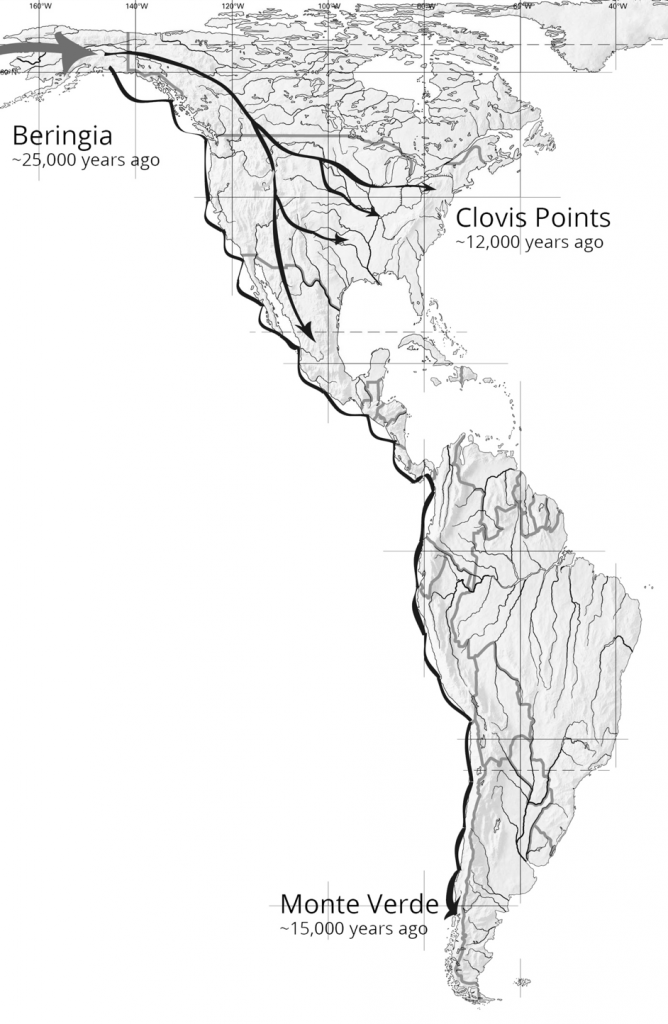
Archaeologists at Monte Verde found stone tools and scraps of mammoth and llama hides, log planks, wooden tent-pegs tied with grass twine, and a wide variety of other plant and animal remains. Nearly a third of the plants found at Monte Verde were charred from cooking, which tells us the new Americans who lived there had a varied diet that included a lot of vegetables. About a quarter of the plants archaeologists have catalogued were not from the immediate area, but had been imported to the site. Seaweeds were found stuck to stone tools, that must have been carried from the Pacific coast 50 kilometers away. Other plant foods had been brought from their high-altitude homes in the Andes or from grasslands up to 600 kilometers away. It’s interesting that more than half these plants are still used by the Mapuche Indians of southern Chile as food, drink, medicine, or construction materials.
Early Americans were not only incredibly mobile, they were remarkably good at learning which local plants were healthy to eat. This knowledge is even more impressive when we recall that as they traveled southward along the coasts of North, Central, and South America, the Beringians left the arctic tundra environment they knew so well, and passed through strange new ecosystems. The explorers crossed the equator and experienced tropical weather for the first time in a thousand generations. But early Americans were apparently very fast learners. According to a leading archaeologist, no one has ever found a plant native to the Americas with food or medicinal value that was not familiar to the pre-Columbian natives.
Monte Verde was an unusual find for archaeologists. Plant remains almost never last more than a couple thousand years, and even bones are rare at most American sites over a few thousand years old. Stone tools are the most common artifacts found, and scientists have been able to trace the movements of ancient Americans by the types of stone they preferred and the tool designs they left behind. When making their tools, ancient Americans chose high-quality minerals that could be accurately chipped into the sharpest, most durable points. Craftsmen actually traveled hundreds of kilometers to particular quarries. For example, dolomite from the Texas Panhandle shows up in spear points found in northeastern Colorado, 585 kilometers away. Blocks of Ohio chert were carried 380 kilometers to Michigan to be chipped into points and blades.
Clovis
The people who made most of the stone spear points found in North America used slightly different techniques from those used by the Monte Verdians. Their style of chipping stone points is distinctive enough that scientists think it represents a new culture in North America, which they called Clovis after the New Mexico town where the first points were discovered in the 1930s. Unlike the first migration of Beringians who traveled down the coast to Monte Verde over fifteen thousand years ago, Clovis people seem to have followed a land route that opened about 12,000 years ago as the glaciers receded. As the two major ice sheets covering the top half of North America began to melt, a gap opened between them on the eastern edge of the Rocky Mountains. Beringians still living in Alaska would have been able to walk south onto the Great Plains, following the animals that also migrated into the new temperate grasslands. And as the ice sheets melted, sea levels began to rise more rapidly. The land route into North America seems to have opened at about the same time the route back to Asia began to close once and for all.
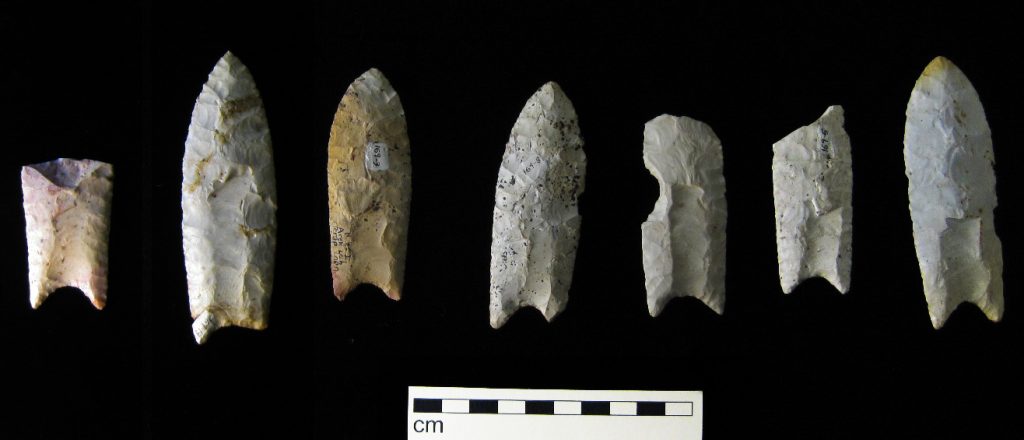
Archaeologists have found many Clovis sites of about the same age throughout North America, leading them to believe the continent may have been completely explored by Clovis people in as little as 500 years. There’s a bit of controversy surrounding the relationship between Clovis people and other groups, because Clovis was discovered first and the discoverers have been reluctant to see Clovis people lose their status as the First Americans. It’s unknown, and a source of ongoing debate, how many coastal travelers like those who made the trip down to Monte Verde might have been in the Americas before the Clovis people. But the evidence is mounting that remains like those of Kennewick Man and Hoyo Negro Girl are from people who lived in the Americas before the Clovis culture arrived. Some people have even suggested that small groups may have managed to cross the Pacific from Oceania or the Atlantic from Africa. Although these possibilities can’t be completely ruled out, DNA evidence shows that most of the ancestors of the early Americans came through Beringia.
The important point is that after countless generations living as hunters in ice age Siberia, Beringia, and Alaska, early Americans quickly adapted their lifestyles to a variety of new American environments. This rapid change may be related to a dramatic drop in large animal populations called the Holocene Extinction. In just about a thousand years, around the time the Beringians entered the Americas, most of the largest mammal species died out. Predators like the Beringian Cave Lion, the Saber Toothed Cat, the Dire Wolf, and the Giant Short-Faced Bear disappeared. Most of the biggest prey species like the Ancient Bison, the Woolly Mammoth, Mastodon, Stag-Moose, and Western Camel also went extinct. Scientists disagree over whether humans caused the die-off through overhunting the animals, or climate change at the end of the ice age eliminated their habitats. In either case, the continent-wide extinction event had dramatic consequences on the people hunting these animals—and also on people who were hunted by them. The disappearance of these species changed the American environment substantially.
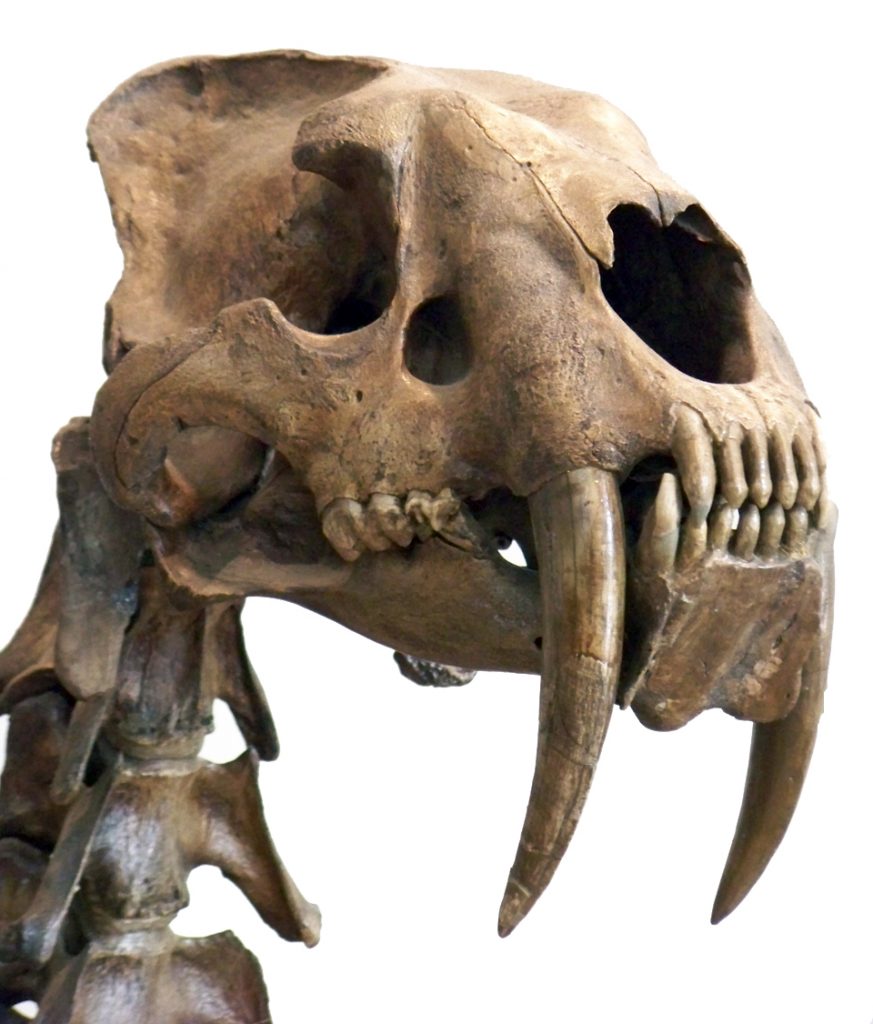
Luckily for early Americans, there were still plenty of large animals to hunt, even if they weren’t quite as big as the ones that had disappeared. The modern bison, although not eight feet tall at the shoulder like its extinct ancestor, still weighs about a ton and its habitat expanded rapidly as ice sheets and melt-water lakes gave way to grassy plains. Smaller quarry for early American hunters included deer, pronghorn, jackrabbits, prairie dogs, and freshwater fish and mussels. The Beringians had brought their dogs with them from Asia, but the only American mammals they were able to domesticate were llamas and their smaller cousins alpaca and vicuña, which they used as pack animals and for their meat, wool and hides. The Americans’ lack of large domesticated mammals caused their societies to develop differently from African, European, and Asian cultures that had beasts of burden such as oxen and horses. However, the early Americans quickly found plants they could expertly adapt to their needs.
Agriculture
Farming was once believed to have developed in the Middle East at sites such as Jericho and Mesopotamia six or seven thousand years ago, where the ancestors of modern Europeans (and the men writing the histories) were usually credited with the invention of agriculture. Then, responding to evidence of prehistoric farming in Africa, India, and China, it was suggested agriculture may have developed more or less independently in several regions of the world. But it was difficult to imagine how such parallel development could have occurred, with people in different parts of the world not only making the same basic discoveries but making them pretty much simultaneously. More recently, scientists have begun to suspect this confusion may reflect the difficulty of finding archaeological evidence, since plant materials decay in the ground much more quickly than arrowheads and stone spear points. And some have suggested we may have been thinking about agriculture wrong.
It now seems likely that agriculture began in a very gradual process that goes back much farther than we had imagined, to a time when hunter-gatherers began favoring certain plants, weeding around them to help them grow, and then transplanting their favorites closer to home. This horticulture or part-time farming may have begun before our ancestors began to spread from Central Europe across Eurasia, which would explain the seemingly coincidental parallel development of farming across the globe. Various regions may have each developed their distinctive versions of what we now recognize as agriculture from a deep pool of common techniques. But whatever the original source of their knowledge, Monte Verdians were already experts at finding and using native plants nearly fifteen thousand years ago. And it didn’t take long for their descendants to begin selectively breeding native American plants into some of the world’s most important staple crops.

Maize, which we call corn, was developed by Central American natives of what is now Southern Mexico beginning about 9,000 years ago. The Central Americans created the single-stem, large-eared maize plant we’re familiar with by very gradually improving a native grass called teosinte. Year after year farmers saved seeds from the best plants with the biggest seed heads. Eventually, after generations of patient improvement these seeds began to look less like grass, and more like what we’d call ears of corn. This process of selective breeding may have taken centuries, and along the way the maize plants lost the ability to reproduce by themselves. Modern corn seeds are trapped on their ears, and most will never germinate unless they’re removed by people and replanted. Today, maize is the world’s most important food crop. Corn feeds billions of people and domesticated animals and produces a wide range of materials for energy, plastics, pharmaceuticals, and other industries.

Potatoes are even older than corn. Papas, as they’re called in the Andes Mountains, were developed by South Americans over the period from 10,000 to 7,000 years ago, in a high-altitude region of what is now Peru and Bolivia. Even today, markets in many Andean villages still sell hundreds of potato varieties people outside the region have never seen. South Americans bred potatoes for a wide range of uses. Farmers were freeze-drying potatoes for long-term storage thousands of years before these techniques were first recorded by Spanish conquistadors. Potatoes were among the first “New World” products carried back to Spain by the conquistadors. They were widely adopted by European farmers and had solved Europe’s recurring famine problem by 1900. British economist Adam Smith called Europe’s attention in On the Wealth of Nations to the fact that fields planted with potatoes instead of wheat would feed three times as many people. Potatoes remain one of the top five staple foods in the world today.
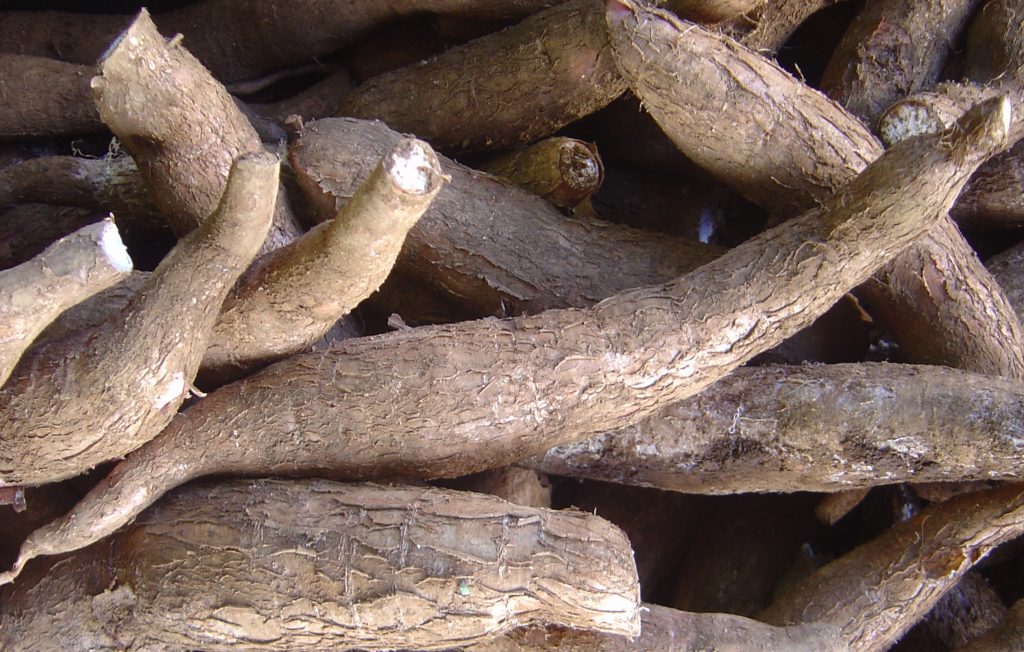
Cassava trees are native to central Brazil, where they were first domesticated between 10,000 and 7,000 years ago. Although the product of the cassava tree, called manioc, is only familiar to most North Americans as the desert tapioca, the processed roots of this jungle tree are another of the world’s top five staple crops. Manioc feeds billions of people in Asia and Africa. But unlike maize and potatoes, the roots of the cassava tree are toxic in their raw form, containing cyanide compounds that must be removed before manioc can be eaten. Processing manioc involves grating, milling, fermenting, drying, and roasting the cassava roots—in various combinations depending on the end-product being produced. So in addition to discovering this food source when they reached Brazil, early Americans had to develop processing technologies to make it useable.
Early American Cultures
Learning to grow and store plant foods in addition to hunting changed everything in the Americas, just as it had in Europe, Asia, and Africa. Nomadic hunter-gatherers who had always followed herds of prey animals began staying in one place, literally putting down roots with the crops they planted. Abundant, regular food supplies allowed populations to grow. Soon people were building the ancient cities whose ruins still amaze us today. Like their cousins in Egypt, India, and Asia, early Americans built remarkable cities. Tiwanaku, located near the shores of Lake Titicaca in the Bolivian highlands, was built about 3,500 years ago. Its 30,000 inhabitants developed a farming technique called flooded-raised field agriculture and covered the hills around the lake with walled terraces. This was an especially impressive achievement since the Tiwanakans were working at some of the highest altitudes ever inhabited by people. The water level of Lake Titicaca is at an elevation of 12,500 feet; the irrigated hills around the lake rise from there.
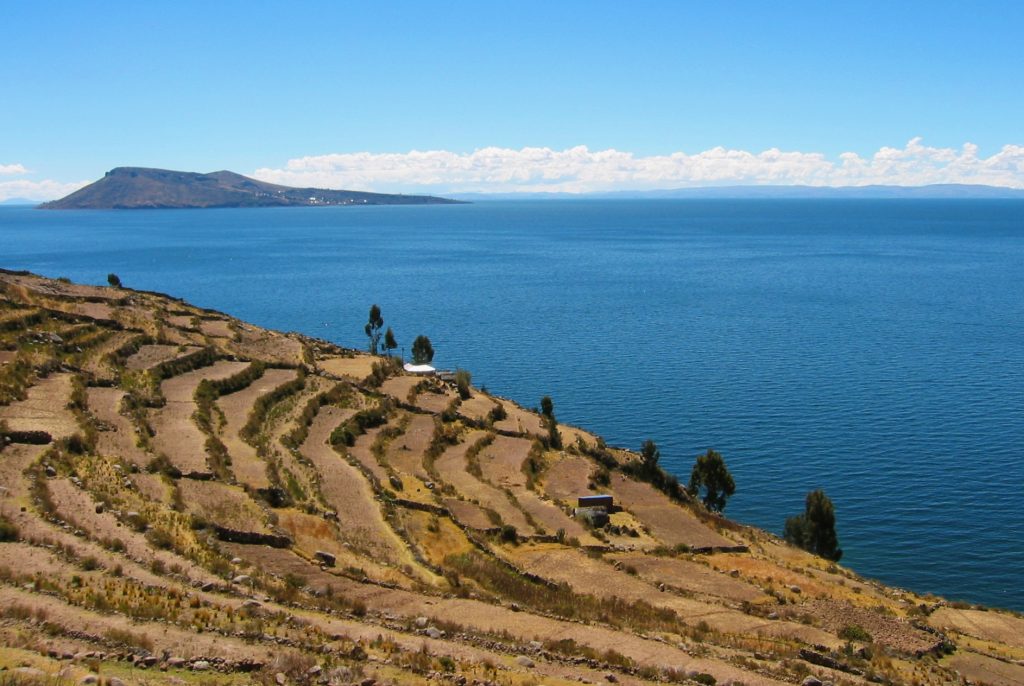
In the twelve thousand years they were cut off from the rest of the world, early Americans developed a variety of civilizations. Many of these cultures existed simultaneously and trade networks developed that carried items like Upper Michigan copper, New England seashells, and Minnesota pipestone across entire continents. Cities such as Cahokia in Illinois, Machu Picchu in Peru, Chichen Itza in Mexico, and Pueblo Bonito in Colorado are just a few of the most visible, well-known remains of native cultures. By the fifteenth century, when the Americans would once again encounter their European cousins, the western hemisphere was probably equal to Europe in both population and culture.
Civilizations rose and fell in the Americas, long before the Americans and the Europeans met again in the fifteenth century. The Mississippian culture of North America peaked around 1200 CE, and seems to have collapsed during the Little Ice Age. The Anaasází or Ancient Pueblo culture of southwestern North America seems to have gone into a similar decline during this period of rapid climate change. The Mayan culture of Mexico flourished between about 1800 BCE and 900 CE. There are several theories about Mayan decline, but the consensus seems to include a combination of overpopulation and agricultural collapse, possibly brought on by increased aridity and desertification. In South America, the Inca Empire called itself Tawantinsuyu, or four parts together, referring to the four distinct ecological regions the Inca joined together to form the largest empire in pre-Columbian America. And many continuously successful regions such as the territory occupied by the Triple Alliance (Aztecs) in the fifteenth century had been home to earlier cultures such as the Toltecs (800-1000 CE) and Olmecs (1500-400 BCE) that were conquered or absorbed by the cultures that followed.

The Triple Alliance capitals of Tenochtitlán and Texcoco, in the Valley of Mexico, each had more than 200,000 inhabitants when they were discovered by the Spanish. Tenochtitlán was built on an island in Lake Texcoco, and was connected to the lakeshore by a series of causeways. Each of the Aztec cities was larger when the Spanish arrived in the Americas than Paris, London, Rome, Venice or Lisbon. In 1492, the region surrounding Lake Texcoco contained at least a million people. Mexico City, which the Spanish built on the ruins of Tenochtitlán, was America’s largest city when the Europeans arrived. It remained America’s largest city in 1600, 1800, and 2000.
The urban Aztecs had a lot of people to feed. They farmed using what we might now call intensive gardening techniques. The Aztecs surrounded their island capital of Tenochtitlán with raised planting-beds called chinampas on floating platforms in Lake Texcoco. This technique allowed Aztec farmers to carefully control soil fertility and watering. The Aztecs supported fifteen people per hectare using chinampas in the fifteenth century. Chinese intensive farming, the most successful agricultural technique known in Europe and Asia, supported only about three people per hectare at the same time.
Although North America had seen its share of city-building cultures such as the Mississippians who built Cahokia, Central and South Americans were much more urban than their northern cousins. And they radically changed the landscapes surrounding their cities. In addition to the Aztec chinampas surrounding Tenochtitlán, the Incas built over 6,000 square kilometers of terraced farms in the Andes. Surrounding Lake Titicaca in Bolivia there were another 5,000 square kilometers of terraces—rising from the lakeside elevation of 12,500 feet. Dotting the eastern slopes of the Andes were cities like Machu Picchu, which was also surrounded by terraces. Many of these sites have been covered and their buildings and terraces torn apart by rainforest trees over the last five centuries, and only recently rediscovered.
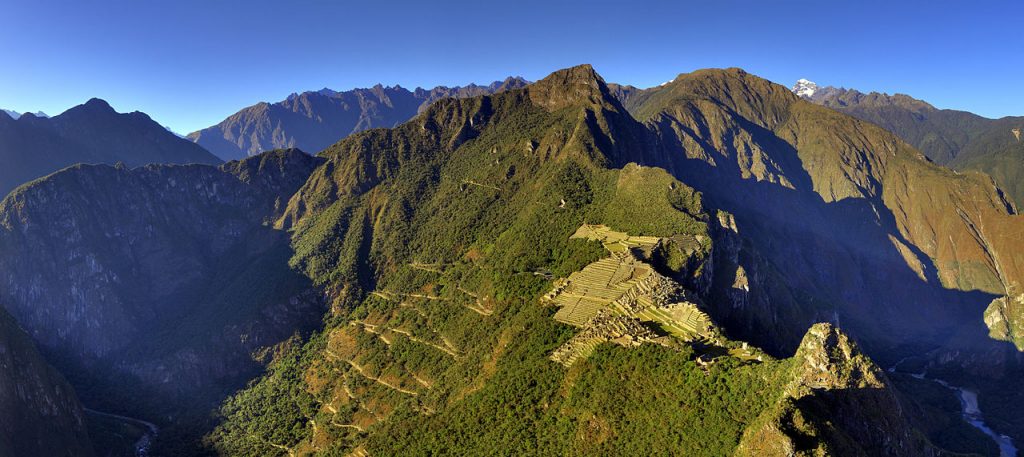
Even more surprising than finding new cites belonging to known American cultures is the recent discovery that some areas where it was never believed the environment could support large populations have hidden completely unknown cultures. The Beni region of Amazonian Bolivia is now believed to have been home to a culture that built raised islands on the river’s floodplain. They connected their island homes with miles of causeways. Although the remains of these earthworks survive, it was assumed they were natural formations until just a few years ago when archaeologists dug into them and discovered they were constructed from the broken shards of old pottery. The earthworks and canals of the Beni still have not been completely mapped.
The Amazon Rainforest was had always been considered extremely inhospitable to civilization. The dense jungle simply couldn’t feed enough people, it was argued. And if the rainforest was cut down to make space for farms, the region’s shallow soils were almost immediately exhausted. But recently, archaeologists have discovered a city called Marajó which was home to over 100,000 people. Marajó thrived on the banks of the Amazon for a thousand years. Instead of the slash and burn agriculture people currently practice in the Amazon, the Marajoara turned the rainforest into an orchard. According to a recent study, the Marajoara grew 138 crops in the forest, more than half of which were trees. And they fertilized their orchards with a charcoal-based supplement called terra preta, which can still be detected in hundreds of square miles of Amazon soils over a thousand years later.
Meanwhile, In Europe
But what about the other Eurasian plains people who had expanded westward, toward Europe? We’ll rejoin them in the next chapter, but one interesting change the ancestral Europeans experienced during their westward trek was, they began drinking milk.

Unlike the Americas, Eurasia was home to several large mammal species that people were able to domesticate. One of these species was the aurochs, a grazing animal like a buffalo that stood about six feet tall at the shoulder. The wild aurochs is now extinct. Although at first it was probably hunted for its meat, aurochs were different from other prey animals. Aurochs were a social species and some would accept humans as the leaders of their herds. The aurochs could be bred in captivity, and they gradually lost their fear of people and allowed themselves to be herded. Over time, in exchange for prime grazing lands and protection from predators, aurochs even allowed themselves to be milked. After hundreds of generations, the wild aurochs became domestic milk-cows.
At the same time, some of the people who began keeping cattle developed a genetic mutation that allowed them to digest cows-milk as adults. The ability to metabolize lactose, the sugar compound in milk, after childhood is not shared by most of the world’s people. Only Europeans and some Africans can digest lactose. In spite of the fact that cows have been familiar companions since the beginning of recorded history, this is a useful reminder that recorded history covers only a tiny sliver of time. Nearly all of the changes that made Native Americans different from the Europeans they met in the Caribbean in 1492 happened recently, after the Eurasian hunter-gatherers who were our ancestors went their separate ways during the last ice age.
Further Reading
Clive Finlayson, The Humans Who Went Extinct: Why Neanderthals Died Out and We Survived. 2010.
David J. Meltzer, First Peoples in a New World: Colonizing Ice Age America. 2009.
Charles C. Mann, 1491: New Revelations of the Americas Before Columbus. 2005.
Charles C. Mann, “1491” (the 2002 Atlantic article that preceded his book): https://www.theatlantic.com/magazine/archive/2002/03/1491/302445/
This is the lecture I give in my class, based on this chapter. It’s about an hour long:
https://youtu.be/Evr3YT-esCQ
Media Attributions
- 153_-_Glacier_Perito_Moreno_-_Grotte_glaciaire_-_Janvier_2010 © Martin St-Amant is licensed under a CC BY-SA (Attribution ShareAlike) license
- Pangea_animation_03 © Tbower is licensed under a Public Domain license
- 2000px-Homo_lineage_2017update.svg © Conquistador, Dbachmann is licensed under a CC BY-SA (Attribution ShareAlike) license
- Landing_of_Columbus_(2) © John Vanderlyn is licensed under a Public Domain license
- Ice_Age_Temperature © Robert H. Rohde is licensed under a CC BY-SA (Attribution ShareAlike) license
- Reindeer-on-the-rocks © Bjørn Christian Tørrissen is licensed under a CC BY-SA (Attribution ShareAlike) license
- Post-Glacial_Sea_Level © Robert H. Rohde is licensed under a CC BY-SA (Attribution ShareAlike) license
- Earth at Last Glacial Maximum © Dan Allosso is licensed under a CC BY (Attribution) license
- Beringia_land_bridge-noaagov © NOAA is licensed under a Public Domain license
- Routes © Dan Allosso is licensed under a CC BY (Attribution) license
- Clovis_Rummells_Maske © Billwhittaker is licensed under a CC BY-SA (Attribution ShareAlike) license
- Smilodon_head © Wallace63 is licensed under a CC BY-SA (Attribution ShareAlike) license
- Maize-teosinte © John Doebley is licensed under a CC BY (Attribution) license
- Patates © Scott Bauer, USDA ARS is licensed under a Public Domain license
- Manihot_esculenta_dsc07325 © David Monniaux is licensed under a CC BY-SA (Attribution ShareAlike) license
- Intikawan_Amantani © PhJ is licensed under a Public Domain license
- la-cuenca-de-mexico-acerca-de-1519-y-hoy © jordan Engel is licensed under a CC BY-SA (Attribution ShareAlike) license
- 1280px-99_-_Machu_Picchu_-_Juin_2009.edit3 © Martin St-Amant is licensed under a CC BY-SA (Attribution ShareAlike) license
- Lascaux_painting © Prof saxx is licensed under a Public Domain license

